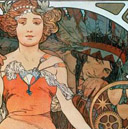0307 Fashioning Modernity at the 1904 Louisiana Purchase Exhibition in St. Louis
Myths of the 'New Woman' and the 'Vanishing Indian'
Identifiers (Article)
Abstract
This essay examines how fashion was complexly constructed and experienced at the Louisiana Purchase Exposition of 1904, better known as the St. Louis World’s Fair. It takes as its point of departure a striking poster illustrated by the Czech artist Alphonse Mucha to advertise the event for a European audience. The image depicts an elegantly clad woman and traditionally dressed Native American joined by the hand – allegorical symbols of the old and new. Ideas about the progressive 'new woman' and the mythical 'vanishing Indian' were evident throughout the fairgrounds in exhibits that showcased art, industry, cultural heritage, entertainment, and American political power. An analysis of photographs taken there by Jessie Tarbox Beals, Frances Benjamin Johnston, and Emme and Mayme Gerhard reveals that sartorial encounters between fairgoers and participants played a key role in articulating the exhibition’s narrative of progress, while also problematizing contemporaneous attitudes towards race and gender.
Statistics


License

This work is licensed under a Creative Commons Attribution-NonCommercial-NoDerivatives 4.0 International License.



